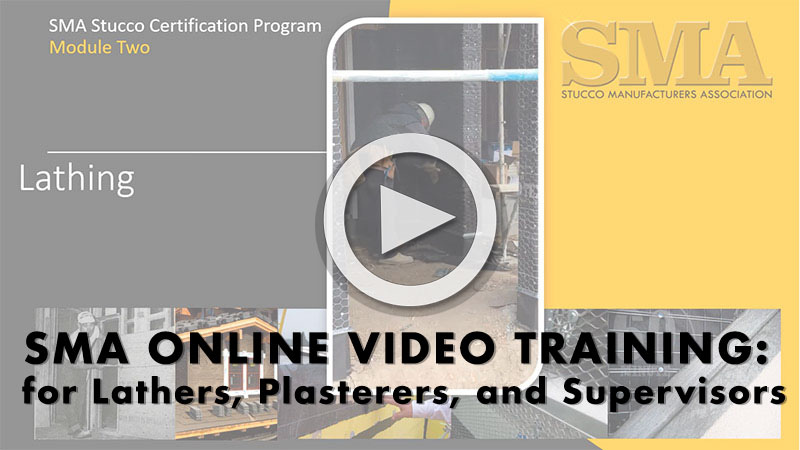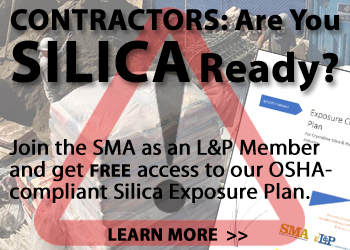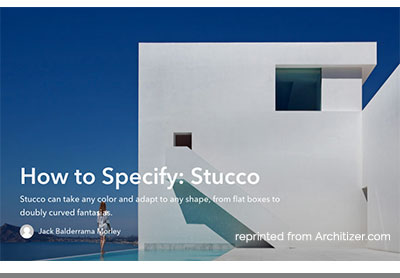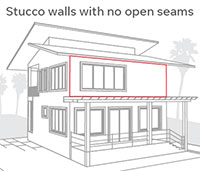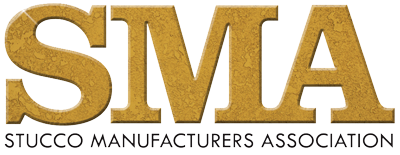FROM THE SMA EXECUTIVE DIRECTOR

Mark Fowler, SMA Executive Director
Fall is upon us, and winter is fast approaching. For those in the stucco industry and not in the south, it also means you need to pay attention to the weather. Frozen materials may be chemically altered and create real problems. It is useful to remember that ASTM C-926-19 requires cement plaster be applied when the ambient air temperature is higher than 40° F (4.4°C), unless the work area is enclosed and heat provided (Section 7.9.3.2). Plaster shall also not be applied to frozen surfaces or a base containing frost. Plaster shall not contain frozen ingredients and protected from freezing for a period not less than 24 hours after set has occurred (Section 7.9.1)
Acrylic finish coats cure like cement. However, the SMA thinks of them as drying more than curing. The acrylic finish can form a hard outer shell and appear to be set. Some plasterers have made the mistake to pull down the scaffold and tenting as soon as the acrylic is hard. However, it must be made sure that the acrylic is cured and adhered to the base coat. If the protection is removed too soon, the first rains will likely cause blisters and delamination issues.
SMA ONLINE EDUCATION/TRAINING
The SMA on-line training program is still underway. We have contracted with a professional firm for translation into Spanish. The program will be released before 2020 arrives. Some contractors have expressed concerns about the program. Any contractor member is invited to participate in the review of the program. In fact, we strongly encourage more feedback. This is a national program and tries to include all regions and be inclusive of regional differences. The cost of the program has not been finalized by the board of directors, but they are well aware it must be affordable to all. The thought to provide the class for free is still on the table. However, if certification is desired, the workload would be substantial for the SMA and added staff would need to be paid. The intent of the program is to ensure the installers “do no harm” when installing lath and stucco. Stucco is an excellent cladding when installed with basic care and understanding of the system. Please see our introductory video [in the sidebar at right] for a preview.
SMA NOVEMBER 6 MEETING — REGISTER ONLINE NOW
 The next meeting for the SMA is November 6 at the Yorba Linda Country Club. [Register here] The speaker is Jacob Belk. Mr. Belk is a renowned forecaster of the residential construction economy. He worked at the Governor’s office, preparing industry forecasts to predict tax revenues, and is well respected for his advice. He spoke last year to the SMA and was well received by the members. He provided handouts that members have used all year to forecast and plan their businesses. His research is undeniably some of the best in the industry. The SMA has been working with Mr. Belk and is happy he feels we are a valued resource as well. His focus is on California, but other areas can learn from his presentation as well. The meeting and lunch start at noon on November 6.
The next meeting for the SMA is November 6 at the Yorba Linda Country Club. [Register here] The speaker is Jacob Belk. Mr. Belk is a renowned forecaster of the residential construction economy. He worked at the Governor’s office, preparing industry forecasts to predict tax revenues, and is well respected for his advice. He spoke last year to the SMA and was well received by the members. He provided handouts that members have used all year to forecast and plan their businesses. His research is undeniably some of the best in the industry. The SMA has been working with Mr. Belk and is happy he feels we are a valued resource as well. His focus is on California, but other areas can learn from his presentation as well. The meeting and lunch start at noon on November 6.
‘STUCCO LIVE’ RETURNS: Las Vegas, February 4-7, 2020
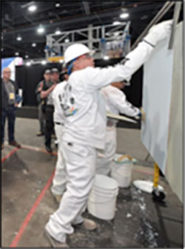 The SMA will again be hosting STUCCO LIVE at the World of Concrete in 2020. STUCCO LIVE 2019 was a great success — and special thanks to our friends at the Operative Plasterers & Cement Masons International Association (OPCMIA). The live demonstrations garnered large crowds to witness the pros at lath and plastering applying their craft. The skill was on display and the audience loved it. This year we’ll have live demonstrations highlighting various manufacturers’ products and systems. The show is February 4-7 at the Las Vegas Convention Center. The 2019 event had record attendance, and 2020 promises to be even bigger.
The SMA will again be hosting STUCCO LIVE at the World of Concrete in 2020. STUCCO LIVE 2019 was a great success — and special thanks to our friends at the Operative Plasterers & Cement Masons International Association (OPCMIA). The live demonstrations garnered large crowds to witness the pros at lath and plastering applying their craft. The skill was on display and the audience loved it. This year we’ll have live demonstrations highlighting various manufacturers’ products and systems. The show is February 4-7 at the Las Vegas Convention Center. The 2019 event had record attendance, and 2020 promises to be even bigger.
SMA GOLF 2019


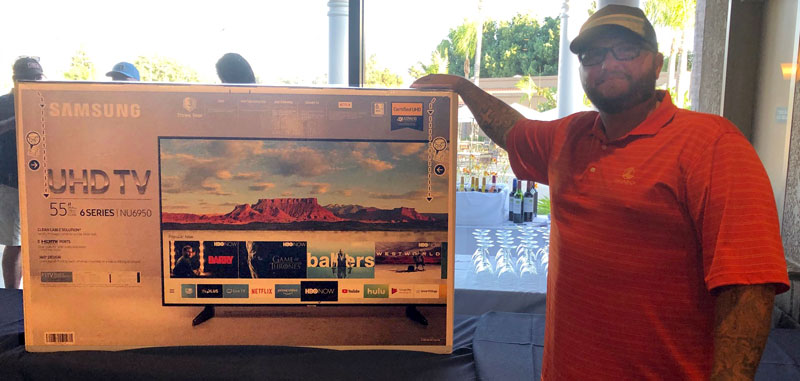
Our annual golf tournament held on September 23 was another success. The Yorba Linda Country Club opened its brand new greens, and the course was in fantastic shape. Thank you to sponsors that make it all happen: Atlas Foam, Thompson Building Materials, La Habra Stucco, Merlex Stucco, Omega Products, Quikrete, CalPortland Cement, and PW Gillibrand Specialty Aggregates.
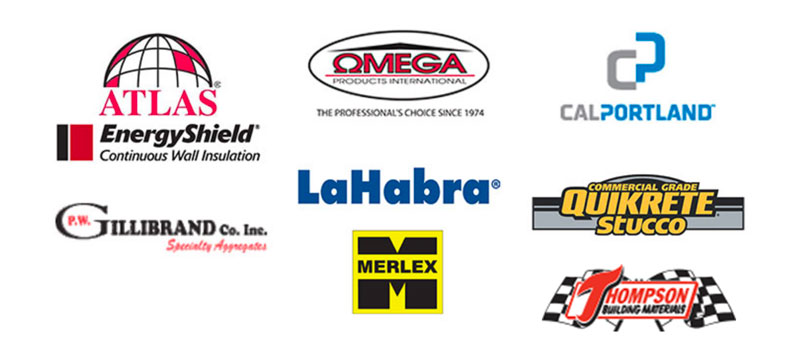
SMA BOARD OF DIRECTORS ELECTION
The SMA will soon be holding elections for an opening on the SMA Board of Directors. All members are eligible to serve. If you have the interest to serve on the SMA board, contact Mark Fowler at Mark@stuccomfgassoc.com. Being on the SMA board requires a commitment to time, and it is a responsibility not to be taken lightly. The SMA board implements plans and projects to better the overall stucco industry for the United States. It is not a platform to gain an edge on your competitors or focus on a single region of the country. The SMA board has an impeccable reputation as being fair and equitable for all. The SMA is blind to conflicts between signatory, merit even double-breasted shops. The Board is comprised of manufacturers, suppliers and contractors. This makes the SMA board unique in that the full industry is represented, nationally, and that we specialize only in lath and plastering.
Feature Articles
ASR — BEWARE
I have always said that plastering is a skilled craft; it requires trade skills and the knowledge that only the experience of working with it can bring. Unfortunately most of the experience that sticks with me is the witnessing of certain failures. This is why networking is so valuable to skilled trades. You can learn from others. ASR is an example and I had no idea what it was, and since working in the terrazzo side, it is a whole new world that stucco people should be cautious. ASR stands for Alkali Silica Reaction. It is known in the concrete industry as “concrete cancer.” It is a swelling reaction that occurs over time between highly alkaline cement paste and the reactive non-crystalline silica found in some aggregates, given sufficient moisture.
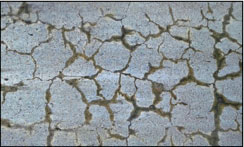 The chemical reaction is extremely complex. In simple terms, the cement paste can attack the siliceous aggregate converting the poorly crystallized or amorphous silica to a soluble alkali silicate. This, in turn, expands and then coverts the gel to solid calcium silicate hydrate. This expansive pressure increases in the core of the aggregate. The accumulated pressure can result in cracks to the aggregate and the surrounding cement paste. The problem is known worldwide, and we in the stucco business should be paying attention. The terrazzo industry has noted the condition and taken steps to prevent this issue of ASR. Portland cement and quartz sand, the aggregate we use, are rarely a problem. ASR has become more noticeable when designers opted for “glass” aggregates over the more traditional marble chips. The industry now recommends to the designer to stay away from glass aggregate.
The chemical reaction is extremely complex. In simple terms, the cement paste can attack the siliceous aggregate converting the poorly crystallized or amorphous silica to a soluble alkali silicate. This, in turn, expands and then coverts the gel to solid calcium silicate hydrate. This expansive pressure increases in the core of the aggregate. The accumulated pressure can result in cracks to the aggregate and the surrounding cement paste. The problem is known worldwide, and we in the stucco business should be paying attention. The terrazzo industry has noted the condition and taken steps to prevent this issue of ASR. Portland cement and quartz sand, the aggregate we use, are rarely a problem. ASR has become more noticeable when designers opted for “glass” aggregates over the more traditional marble chips. The industry now recommends to the designer to stay away from glass aggregate.
Why is this important to us?
Silica dust exposure was, and still is, a concern to plastering. It might seem a logical next step to consider switching to a recycled glass as a substitute. Glass is made of sand and, essentially, also a silica. But this silica is chemically altered when it is turned to glass, making the dust not a crystalline silica. Since ground glass is not a crystalline silica, this could tempt some to replace this glass over traditional quartz sand, which is crystalline silica and falls under the OSHA rules. We should be careful about jumping to solutions without vetting all the ramifications.
SNAPSHOT OF THE ECONOMY
The FMI Third Quarter 2019 North American Engineering & Construction Outlook has released its report on the economy. This report features comprehensive construction forecasts for the U.S. and Canada as well as information on key market drivers. Contact the SMA office if you would like a copy of the FMI report.
Key highlights of the report include:
- Total engineering and construction spending for the U.S. is forecast to end up <1 percent in 2019, compared to up 3 percent in 2018.
- U.S. spending growth in 2019 is expected to be led by public investment across both nonresidential buildings and nonresidential structures. Current top-performing segments forecast in 2019 include conservation and development (+10 percent), water supply (+9 percent), public safety (+9 percent), transportation (+8 percent) and sewage and waste disposal (+8 percent).
- Only one U.S. segment was upgraded into our growth category through the second half of 2019, lodging. On the other hand, the commercial market was the only segment downgraded, from stable to down. Despite stable fundamentals, all three residential segments continue to show weakness and are expected to end this year below 2018 spending levels.
- FMI’s Nonresidential Construction Index (NRCI) at 50.4 is the lowest score recorded in more than seven years. An index score over 50 suggests improving or expanding industry conditions.
- Several of Canada’s segments, including conservation and development, power, public safety, sewage and waste disposal, and water supply, were upgraded into our growth category through the second half of 2019. In contrast, the lodging and office segments were downgraded from growth to down.
US CENSUS DATA: Privately owned housing starts in September 2019 were at a seasonally adjusted annual rate of 1,256,000. This is 9.4 percent (+/- 9.4%) * below the revised August 2019 estimate of 1,386,000.
Snapshot on US Housing Starts :
- September 2019: -9.4* % change
- August 2019 (r): +15.1 % change
ASTM NEWS
 ASTM C 1861 is the new ASTM that pulled trim accessories out of the old ASTM C 1063. This ASTM goes into detail on the specifications for the trims used in cement plaster. Several pages are dedicated to illustrations of trims used in plastering and a name assigned to each trim. Table 3 covers the Fasteners and the length required to attach the various trims to framing members. Table 1 covers minimum thickness required for the trim accessory. Table 2 is for Cold-rolled Channel Furring.
ASTM C 1861 is the new ASTM that pulled trim accessories out of the old ASTM C 1063. This ASTM goes into detail on the specifications for the trims used in cement plaster. Several pages are dedicated to illustrations of trims used in plastering and a name assigned to each trim. Table 3 covers the Fasteners and the length required to attach the various trims to framing members. Table 1 covers minimum thickness required for the trim accessory. Table 2 is for Cold-rolled Channel Furring.
ASTM C 1860 is also new. For decades there was no test to verify the bond of cement plaster to masonry or to itself. ASTM C 1860 addresses this. This is a test method with procedures to determine the tensile strength of Portland cement-based plaster. The test is appropriate for new and existing construction if the plaster has been in place a minimum of 28 days. This is a bonding test and not intend to evaluate the underlying construction or framing the test methods are intended to be used as a tool to quantitatively evaluate the existing Portland cement plaster cladding that is suspected of questionable bond or uncertain fastening to the substrate. Test method A and B are essentially cut squares where the stucco is pulled off the wall. The SMA is still evaluating the value and how it will ultimately impact the stucco industry. This may be more about how it is used, by whom and for what purpose.
PLEASE NOTE: SMA OFFICE CONTACT INFORMATION
Mark Fowler, Executive Director
Marlene Lampert, Office Manager
Stucco Manufacturers Association
5753 E Santa Ana Cyn Rd, Suite G-156
Anaheim, CA 92807
Office: 714-473-9579
Mark@stuccomfgassoc.com
Marlene@stuccomfgassoc.com
REMEMBER: The SMA has a fairly large library on all things stucco. Members of the SMA are encouraged to call the SMA office if the staff can be of any assistance.

